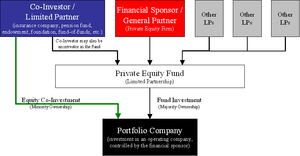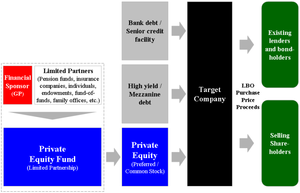A new study finds that financial-sponsor-backed companies are outperforming their publicly held peers.
CFO.com: Vincent Ryan Follow on Google
... From 2006 to 2012, E&Y found in its recent study of North American PE deals, PE-backed firms spawned a return of more than five-fold that of investor returns on publicly held companies.
 |
| English: Diagram of private equity fund structure for Private equity, Private equity fund, Private equity firm (Photo credit: Wikipedia) |
 |
| English: Diagram of private equity co-investment structure for Equity co-investment (Photo credit: Wikipedia) |
 |
| Diagram of leveraged buyout transaction structure for Private equity, Leveraged buyout (Photo credit: Wikipedia) |
“In the 1990s and the 2000s, if PE firms bought at the right time and then held the investment, they made money based on the multiples expansion in the public markets,” says Jeffrey Bunder, global private equity leader at Ernst & Young. Now, however, PE firms are concentrating on driving earnings growth, he says.
 |
| English: Different methods to assess value on the secondary market (Photo credit: Wikipedia) |
But it would be wrong to suggest that the old value creators for private-equity firms no longer contribute. Higher stock market returns still drove 17 percent of PE-owned companies’ overall returns, and the additional leverage PE-backed companies took on accounted for 25 percent of overall returns. In addition, cost reduction at acquired businesses still drove 26 percent of EBITDA growth for the deals PE firms existed during 2006 to 2012.
Healthy equity markets have also enabled successful exits of private-equity-backed firms through initial public offerings. And even the multiple-expansion effect has returned. “Multiples, which compressed significantly during the post-crisis years and negatively impacted performance, have rebounded in the recovery period and accounted for 30 percent of overall PE returns,” the E&Y report says.
PE firms indeed are holding companies longer — an average of 5.1 years in the study’s deal population in 2012, up from 3.4 in 2006. While the Great Recession certainly had something to do with that, “longer hold periods … also point to increased engagement by PE owners in the businesses they back,” said the E&Y report.
For the study, Bunder’s team analyzed deals that PE firms exited during 2006 to 2012. They chose acquisitions that had an initial value of $150 million or higher.
'via Blog this'










No comments:
Post a Comment